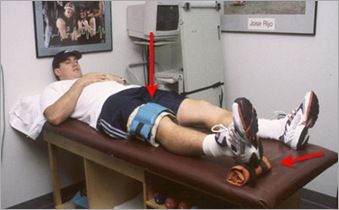Q: I have a girl with very serious knee issues. She has already had a partial left medial meniscectomy, and the docs are ready to “clean her up” again. My tests showed horrible ankle and hip mobility, a left hip impingement, and she’s on her way to a knee replacement at 30 if we don’t get her fixed!
At what point could we start focusing on getting her some knee extension? She’s not even getting to neutral as we speak.
This is a great question, and one I think more people need to address. While the joint-by-joint approach gives us a greater idea of what’s going on from a global perspective, we can’t forget to evaluate the specific (local) joint in our diagnostic process.
I was first exposed to the importance of knee extension by Dr. Shelbourne, a world-renowned surgeon known for his accelerated ACL rehabilitation approach. While he’s a bit of a lightening rod within the industry, Dr. Shelbourne really knows his stuff.
First and foremost, here’s how you test knee extension:
Place your patient/client/athlete on a treatment table with legs straight. If testing their left leg, stand to the client’s left and use your right hand to hold down their thigh, placing your hand just above the patella.

With your left hand, cup their ankle/Achilles tendon and gently pull the lower leg upwards (although this isn’t how it’s shown in the picture!).
In this case, you’re looking for three things:
1) Quantity of motion.
The client should typically have between 5 and 10 degrees of hyperextension at the knee.
2) Quality of motion.
The knee should have a nice, soft end feel. It should not feel abrupt or stiff.
3) Symmetry between sides in quantity and quality.
This one is pretty self-explanatory. If they’re lacking in quantity or quality on one side versus the other, this should be addressed.
If knee extension is asymmetrical or lacking between sides, this should be addressed first and foremost within a program. Obviously you can still address other limiting factors (hip and ankle mobility, hip stability and control, etc.), but knee extension is crucial. Research by Shelbourne [1] has shown that a 3-5 degree loss of extension 10 years post-surgery can lead to decreases in subjective and objective knee health.
It sounds like you’re on the right path with her programming overall, but I would really start to hammer knee extension ASAP and see if that doesn’t get her some immediate improvement in how her knee feels.
I hope this helps. Good luck!
Best
MR
1. Shelbourne, K.D. and T. Gray, Minimum 10-year results after anterior cruciate ligament reconstruction: how the loss of normal knee motion compounds other factors related to the development of osteoarthritis after surgery. Am J Sports Med, 2009. 37(3): p. 471-80.

